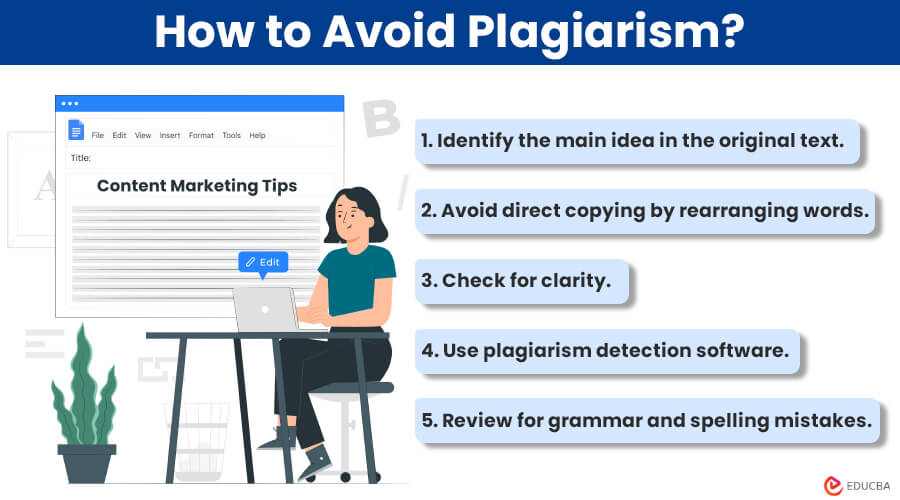How to Avoid Plagiarism in Content Marketing?
Copying someone else’s work and content and presenting it as our own is plagiarism. It is a highly serious issue that can severely affect academic and professional work life. Therefore, ensuring that all written content is original and cited is essential to avoid accidental or intentional plagiarism. This article will discuss the top 5 easy steps to avoid plagiarism and how to create original, high-quality writing work.

#1: Identify the main idea in the original text
One of the best tips to effectively rewrite text or content is to understand the purpose and main points of the original content. This is crucial to ensure that you accurately convey the same or original information in your way. Before you start rewriting, take time to read and comprehend the original meaning thoroughly. Then, list the main points and ideas presented in the original text, and consider how you can express these ideas in your own words. Hence, when you fully understand the original text, you can rewrite it in your own style while staying true to the original.
#2: Avoid direct copying by rearranging words
Another way to avoid plagiarism is to use alternative words or phrases in your writing. This can help you avoid directly copying someone else’s exact sentences or phrases and ensure that your writing is more original.
It is important to remember that simply replacing a few words in a sentence does not make the work original. You need to revise and rewrite the ideas thoroughly. One way to do this is using this innovative rewording tool by rewritetool to rephrase sentences and paragraphs or express others’ ideas in your words rather than directly copying the original text. However, be careful when using this technique, as rearranging the words in a sentence without changing the overall meaning can still be plagiarism if you don’t give credit (citation) to the original source.
How to use a Thesaurus or Dictionary?
Using a thesaurus or dictionary is an effective way to improve your content’s overall quality and clarity.
- Use related synonyms without changing the main meaning if there are boring or repetitive words.
- Use precise and accurate words or terminology to meet professional standards.
- Remove unnecessary jargon and complex words and replace them with simple words to make content understandable for readers among diverse demographics and those unfamiliar with complex language.
#3: Read it aloud to check for clarity
Reading your work aloud is a simple but effective way to identify any awkward phrasing or unclear sentences from directly copying someone else’s work. These issues may not be immediately noticeable when reading silently, but when you read aloud, it becomes much easier to identify any awkwardness or lack of clarity in the writing.
When you read aloud, you can spot any large blocks of text (chunks) copied without proper citation. Breaking down these chunks and citing the original source may avoid unintentional plagiarism and ensure your work is completely original. This technique can also help you better understand the structure and flow of your writing, allowing you to identify areas that need further revision or clarification.
#4: Use plagiarism detection software
Finally, use plagiarism detection software to ensure your work is original and plagiarism-free. A plagiarism detector can provide an added layer of verification, scanning for any unintentional overlaps with existing content. These tools scan your work for any instances of copied or plagiarized text and can help you identify areas that need further revision to ensure that your work is original.
However, these tools are not always perfect and reliable because they cannot always identify every instance of plagiarism.
#5: Review for grammar and spelling mistakes
The fifth tip to improve your rewritten text is double-checking for grammar and spelling errors. Poorly written text can turn off readers and negatively impact your search engine ranking. To ensure that the content is of high quality, it is important to proofread it carefully for any mistakes. This might be a tedious task and can take longer, but it is essential for creating great content that is clear, concise, and free of mistakes.
Consider using a grammar checker or ask colleagues or friends to review your content and identify any errors that you may have missed. Pay special attention to homophones, i.e., words that sound the same but are spelled differently, such as “their” and “there”, as these are common sources of errors.
Final Thoughts
In conclusion, avoiding plagiarism is crucial for producing high-quality, original written content. You can follow the easy steps discussed in this article and take time to revise and edit your content properly. It will ensure that your work is original, clear, concise, properly cited, clear, concise, and plagiarism-free.
Recommended Articles
We hope this article on how to avoid plagiarism was beneficial. You can also refer to the articles below to learn more about related topics.

